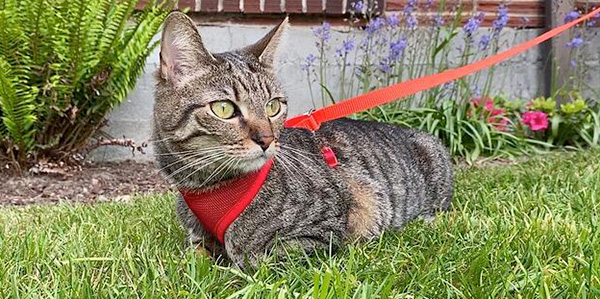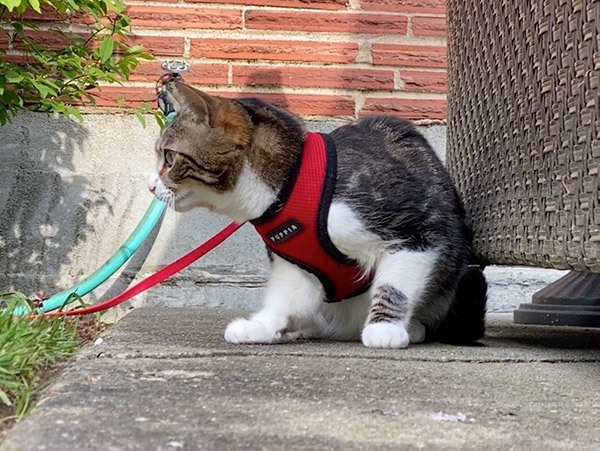 Wondering if your cat would enjoy a walk outside or if you can walk a cat on a leash?
Wondering if your cat would enjoy a walk outside or if you can walk a cat on a leash?
Harness training your cat can be a wonderful way to let them explore the outdoors more safely than they could otherwise.
There are some things to consider and steps to take before training your cat to walk on a leash.
Start with our How to Put on a Cat Harness article to learn what cat temperaments are best suited for harness and leash training, how to select the best harness and leash, and the process of helping your cat feel comfortable wearing the harness. Then you’re ready to dive into leash training!
Training Your Cat to Walk on a Harness and Leash
At this point, your cat should be comfortable spending time in their harness. Before you attach the leash and head outside for a walk, it’s a good idea to do a little training in controlled conditions first. There are many safety concerns to be mindful of, so understanding your cat's behavior and starting indoors is best.
If your cat is clicker trained, incorporate the clicker into this entire process.
If your cat loves treats as rewards, have some ready. I like puree options because your cat can eat them quickly. Treats like Churu squeeze treats or you can also water down a little of their wet food so it will flow easily through a syringe or just give a lick of wet food off a spoon.
Step 1: Get your cat used to walking with the leash attached to the harness.
Depending on their comfort level, you can start with just a few seconds and gradually increase the amount of time the leash is attached. Provide rewards along the way, in the form of treats, pets, or praise, each time your cat responds calmly.
Safety tip: Avoid letting your cat drag the leash, especially unsupervised. With all their jumping over and crawling under things, they can easily get the leash caught on something. And that can be dangerous.
Step 2: Practice leash walking your cat around your home.
Allow your cat time to get used to moving in the harness and understanding that the leash will sometimes guide or limit their movements. Reward calm behavior throughout. If your cat gets anxious at any point, take off the leash (and harness, if needed), end on a good note with a treat and some verbal praise, and try again later.
Here’s a video of a Preventive Vet team member going through the process with his cat, Rajah. I don't think Rajah suffered or was overly stressed in any way, but putting the harness on seemed to be a bit forced. So, you'll want to take it a bit slower and follow the steps in our How to Put a Cat Harness On article. It's the flop over just after Rajah's harness went on that is what we want to try and avoid. He seemed a bit tentative on the first walk outside, but that is normal for a cat's first outdoor adventure.
During this time, you should be getting yourself familiar with the way the harness moves with your cat.
Does it apply pressure that might cause them discomfort if pulled certain ways?
Do you have it tight enough to keep them secure but loose enough to let their bodies move, expand and contract with breathing, etc.?
Can your cat somehow get one foot stuck up through the neck hole like yours truly?
Cats might as well be made of playdough the way they can wiggle in and out of things. It’s important for you to understand what control the harness and leash give you over your cat before you go outside.
Can Cats be Trained to Walk on Leash?
Who knew cats needed all this training, right? Here’s how a cat looks at the process:
You: Hey kitty, I’d like you to do X. If you’re willing to do X, I’ll compensate you with this treat.
Cat: I like that treat and doing X isn’t too bad. I agree to your proposal, with the following stipulation: These so-called “training sessions” are to last no more than a few minutes at a time. Agreed?
You: Agreed.
Throughout the leash training process, be careful not to push past your cat’s comfort level. Just as you did in getting them used to the harness, you’ll take baby steps and reward after each calm reaction from your cat. Training should always be fun for both of you. If your cat isn’t enjoying it, they won’t be receptive to learning. In fact, they’ll just leave. So, keep it light and positive.
And it’s important to know what to expect with leash training. For cats, walking on a leash is about giving them a safer way to enjoy the sights, sounds, and smells of the outdoors. A cat is less likely than a dog to stay focused on you or follow verbal cues with everything going on around them. That’s not to say it can’t happen with a lot of training. But it’s not their natural state. They’re programmed to respond instinctively versus looking to their human for guidance or protection. The harness and leash give you some control over where they go, so you can guide them back inside when the time comes.
Alternatives to Teaching Your Cat to Walk on a Leash
If you have a nervous kitty or just aren’t sure how they’ll react to the great outdoors, you might want to start them out with some time in a catio. This is a protected way they can get familiar with the sights, sounds, and smells they’ll encounter on your walk. If they’re comfortable in the catio setting and their harness, it’s finally time to venture out.
If you live in a condo or apartment, you might try a cat stroller to expose them to the outdoors while keeping them physically secure and helping them feel safe.
Just as you did with all the previous training, exposure to a catio or stroller time outside should be done slowly, in a way that doesn’t cause stress or fear for your cat, with lots of positive reinforcement along the way. Always watch body language and end the session if you see signs of stress like:
- Crouching or cowering
- Being frozen in place
- Ears turned to the side or down
- Eyes darting around
If leash walks just aren't your cat's thing, there are plenty of other ways to provide enrichment and prevent boredom.
Bonus Tips for Walking Your Cat on Leash
Teach your cat a few basic verbal cues like Sit, Stay and Look at Me. In a scary or dangerous situation outside, your cat is likely going to act on instinct. But you may be able to help keep them calmer and more focused with these cues. They also just make life easier. If you want to take it to the next level, you can work on many of the same techniques used in dog walking, like heel and direction changes.
Check out How to Walk Your Cat on a Leash Safely to learn more about venturing outside and some of the unique situations and safety precautions that come along with taking your cat for a walk.
When your cat is feeling confident and comfortable in their harness and leash, and you’re just as confident and comfortable handling them, it’s time to head outside. But don’t just open the door and go for it! For a glimpse at what a comfortable leashed walk with a relaxed cat looks like, check out a friend of Preventive Vet, Christine Edwards, with her cat Mr. Eko taking a stroll.




